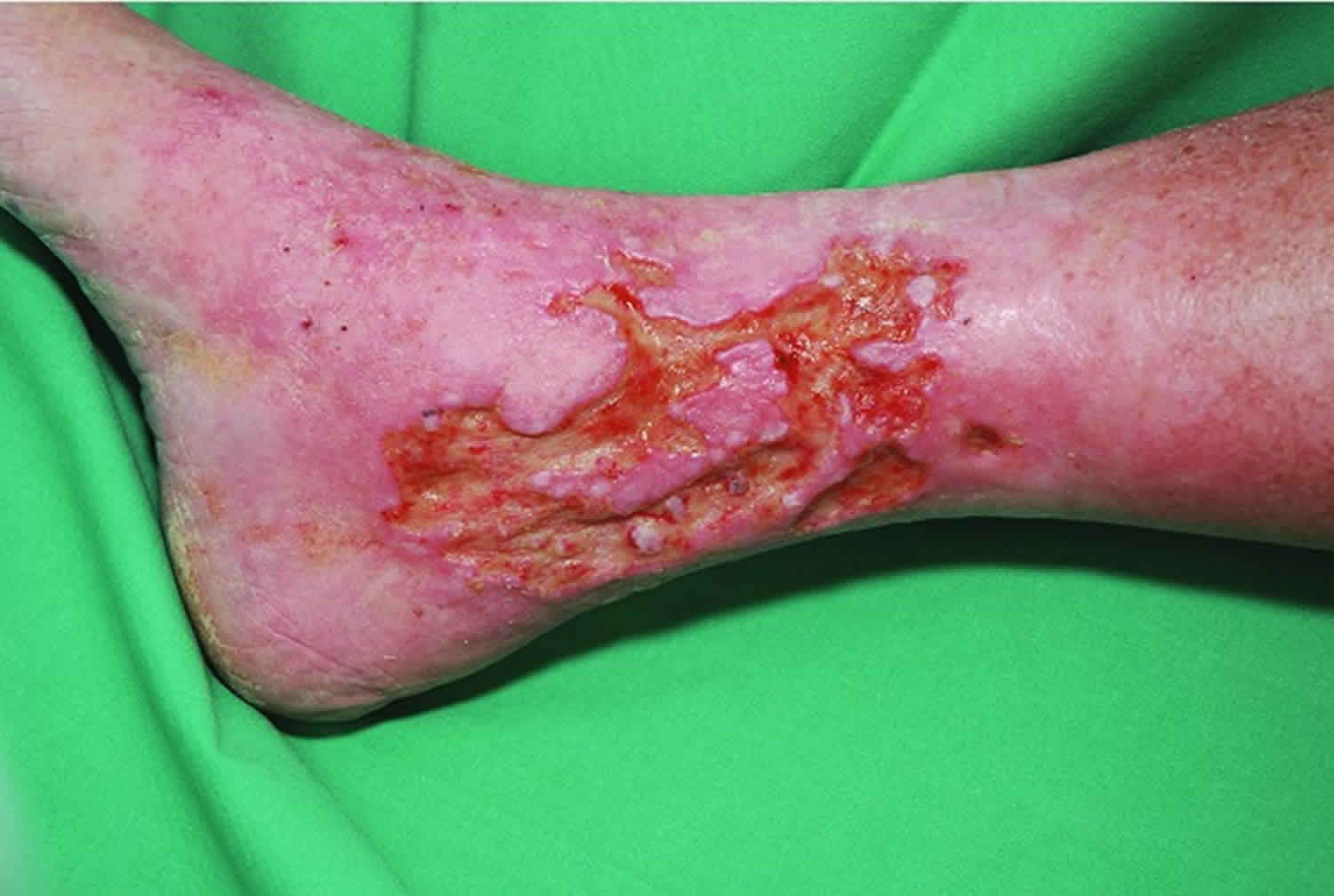What are the symptoms of a venous ulcer?
Venous ulcers, also known as venous stasis ulcers, typically occur on the lower legs and are associated with chronic venous insufficiency. The symptoms of a venous ulcer may include:
- Pain: The ulcer can be painful, with the intensity of pain varying from mild to severe. Pain often worsens with prolonged standing or walking.
- Swelling: The affected leg may experience swelling, especially around the ulcer and in the lower leg.
- Skin Changes: The skin around the ulcer may appear discolored, ranging from red to brown. This discoloration is due to the buildup of iron from red blood cells (hemosiderin).
- Ulcer Characteristics: The ulcer itself typically has irregular, shallow borders and may have a red or pink base. It is often located on the lower leg, above the ankle, usually on the medial side (inner aspect of the leg).
- Itching or Burning: The area around the ulcer can be itchy or have a burning sensation.
- Infection Signs: If the ulcer becomes infected, symptoms may include increased redness, warmth, swelling, pus or other discharge, and fever.
- Dry or Weepy Skin: The skin around the ulcer may be dry and flaky or have a weepy appearance with a serous or bloody discharge.
Venous ulcers often result from poor blood circulation in the veins of the legs, leading to increased pressure and fluid leakage. Effective management usually requires addressing the underlying venous insufficiency and may involve wound care, compression therapy, and lifestyle changes. If you notice symptoms suggestive of a venous ulcer, consulting a healthcare provider for proper diagnosis and treatment is important.
What are the causes of a venous ulcer?
Venous ulcers are primarily caused by chronic venous insufficiency (CVI), which impairs the normal flow of blood through the veins in the legs. Several factors contribute to the development of venous ulcers:
1. Chronic Venous Insufficiency (CVI):
- Venous Valve Dysfunction: Weak or damaged valves in the veins fail to prevent blood from flowing backward, causing blood to pool in the lower legs.
- Venous Hypertension: Increased pressure in the veins leads to fluid leakage into surrounding tissues, which can damage the skin and lead to ulcer formation.
2. Deep Vein Thrombosis (DVT):
- Previous Blood Clots: History of DVT can damage vein valves, leading to long-term venous insufficiency and increasing the risk of venous ulcers.
3. Vein Obstruction:
- Varicose Veins: Enlarged, twisted veins can impair blood flow and contribute to venous insufficiency.
- Venous Obstruction: Conditions or physical blockages, such as tumors or scar tissue, can obstruct blood flow and exacerbate venous insufficiency.
4. Risk Factors:
- Age: Older age increases the risk of venous insufficiency and ulcers.
- Obesity: Excess weight puts additional pressure on the veins in the legs, contributing to venous insufficiency.
- Prolonged Standing or Sitting: Jobs or activities that involve long periods of standing or sitting can impair blood flow and increase the risk of venous ulcers.
- Pregnancy: The increased pressure on the veins from the growing uterus and hormonal changes can contribute to venous insufficiency.
5. Inherited Conditions:
- Genetic Predisposition: Family history of venous insufficiency or varicose veins can increase susceptibility to venous ulcers.
6. Other Medical Conditions:
- Diabetes: Diabetes can affect circulation and healing, making ulcers more likely to develop and harder to heal.
- Peripheral Artery Disease (PAD): Although more commonly associated with arterial ulcers, PAD can contribute to venous insufficiency and ulcer formation.
Effective prevention and management of venous ulcers often involve addressing these underlying causes and risk factors. This may include managing venous insufficiency through compression therapy, lifestyle changes, and treating any contributing conditions.
What is the treatment for a venous ulcer?
The treatment for venous ulcers aims to address the underlying cause of venous insufficiency, promote healing of the ulcer, and prevent recurrence. Key components of treatment include:
1. Compression Therapy:
- Compression Bandages or Stockings: Applying compression helps reduce swelling, improve blood flow, and facilitate healing. Compression therapy is often the cornerstone of venous ulcer treatment.
2. Wound Care:
- Cleaning and Dressing: Regularly cleaning the ulcer and applying appropriate dressings (e.g., hydrocolloid, foam, or alginate dressings) helps protect the wound, manage exudate, and promote healing.
- Debridement: Removal of necrotic tissue or debris from the ulcer may be necessary to aid healing and prevent infection.
3. Management of Venous Insufficiency:
- Elevation: Elevating the legs above heart level helps reduce venous pressure and swelling.
- Exercise: Encouraging regular physical activity, such as walking, helps improve venous return and reduce symptoms.
4. Medication:
- Topical Treatments: Use of topical antibiotics or antiseptics may be indicated if there is an infection present.
- Systemic Medications: In some cases, oral medications or diuretics may be used to manage swelling or treat related conditions.
5. Treating Underlying Conditions:
- Managing Comorbidities: Conditions such as diabetes should be managed effectively to promote wound healing and overall health.
6. Surgical and Procedural Interventions:
- Surgical Repair: In cases of severe or non-healing ulcers, surgical interventions to repair venous valves or remove varicose veins may be considered.
- Endovenous Laser Therapy (EVLT) or Radiofrequency Ablation (RFA): These procedures are used to treat varicose veins and improve venous flow.
7. Lifestyle Modifications:
- Weight Management: Maintaining a healthy weight helps reduce pressure on the veins.
- Avoiding Prolonged Immobility: Avoiding long periods of standing or sitting helps prevent blood from pooling in the legs.
8. Regular Follow-Up:
- Monitoring Progress: Regular follow-up with a healthcare provider is important to monitor the healing of the ulcer, adjust treatment as needed, and address any complications.
Effective management of venous ulcers involves a comprehensive approach that addresses both the ulcer itself and the underlying venous insufficiency. If you have a venous ulcer or are at risk, consulting with a healthcare provider for a personalized treatment plan is essential.

Leave a Reply
You must be logged in to post a comment.